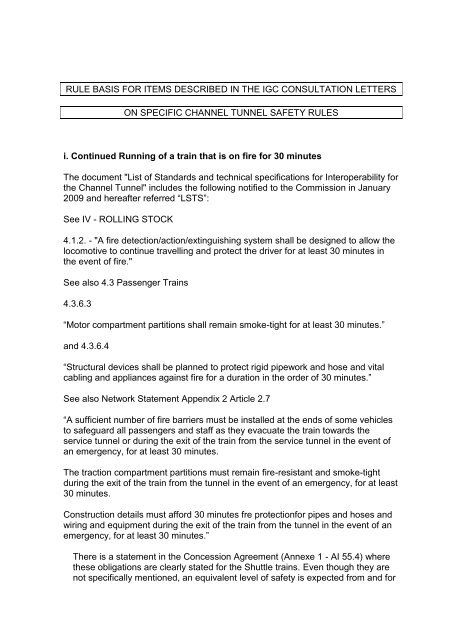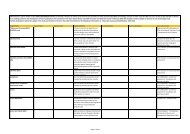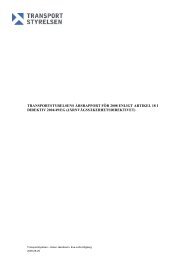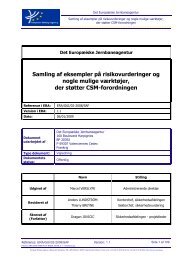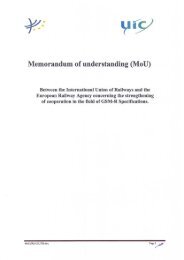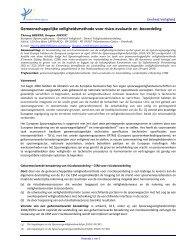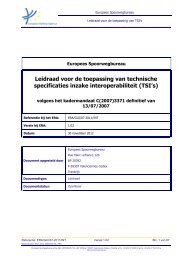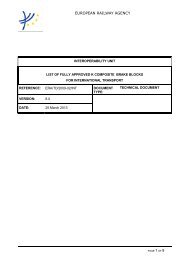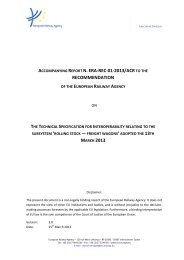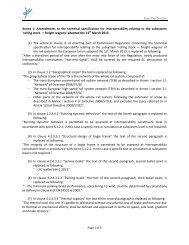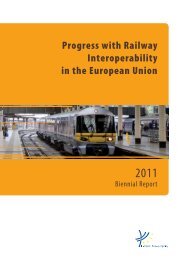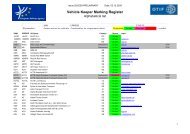Appendix 2 - ERA
Appendix 2 - ERA
Appendix 2 - ERA
Create successful ePaper yourself
Turn your PDF publications into a flip-book with our unique Google optimized e-Paper software.
RULE BASIS FOR ITEMS DESCRIBED IN THE IGC CONSULTATION LETTERS<br />
ON SPECIFIC CHANNEL TUNNEL SAFETY RULES<br />
i. Continued Running of a train that is on fire for 30 minutes<br />
The document "List of Standards and technical specifications for Interoperability for<br />
the Channel Tunnel" includes the following notified to the Commission in January<br />
2009 and hereafter referred “LSTS”:<br />
See IV - ROLLING STOCK<br />
4.1.2. - "A fire detection/action/extinguishing system shall be designed to allow the<br />
locomotive to continue travelling and protect the driver for at least 30 minutes in<br />
the event of fire."<br />
See also 4.3 Passenger Trains<br />
4.3.6.3<br />
“Motor compartment partitions shall remain smoke-tight for at least 30 minutes.”<br />
and 4.3.6.4<br />
“Structural devices shall be planned to protect rigid pipework and hose and vital<br />
cabling and appliances against fire for a duration in the order of 30 minutes.”<br />
See also Network Statement <strong>Appendix</strong> 2 Article 2.7<br />
“A sufficient number of fire barriers must be installed at the ends of some vehicles<br />
to safeguard all passengers and staff as they evacuate the train towards the<br />
service tunnel or during the exit of the train from the service tunnel in the event of<br />
an emergency, for at least 30 minutes.<br />
The traction compartment partitions must remain fire-resistant and smoke-tight<br />
during the exit of the train from the tunnel in the event of an emergency, for at least<br />
30 minutes.<br />
Construction details must afford 30 minutes fre protectionfor pipes and hoses and<br />
wiring and equipment during the exit of the train from the tunnel in the event of an<br />
emergency, for at least 30 minutes.”<br />
There is a statement in the Concession Agreement (Annexe 1 - AI 55.4) where<br />
these obligations are clearly stated for the Shuttle trains. Even though they are<br />
not specifically mentioned, an equivalent level of safety is expected from and for
the other passenger trains. Hence the mention of equivalent specifications in the<br />
Submission to the IGC for TransManche Super Trains (TMST) :<br />
- Submission to the IGC (IGC 10/01/003) from 27/07/1989 - Point 2.3.3<br />
"Precautions against fire".<br />
- Submission to the IGC (IGC 10/01/025) from 02/03/1993 - Point 3.6 "Fire<br />
precautions" (additional points).<br />
The Avant-Projet 12 - "Shuttle trains - Tourist wagons", in line with the<br />
Concession Agreement requirements, describes the design and equipment in<br />
place to allow the safe 30 minutes running out of the tunnel, for shuttles.<br />
ii. Traction requirements<br />
See LSTS III - Track and gauges.<br />
Article 3.1.1<br />
See LSTS 4.3 Passenger Trains<br />
4.3.4.1 (where the requirement quoted in the IGC letter appears)<br />
« Electric locomotives shall be ... able :<br />
* to traverse maximum inclines of 11 per thousand;<br />
* to remove a train of the same type in distress from the tunnel<br />
* and to evacuate its own train from the tunnel from a standstill, 50% of its tractive<br />
performance available.”<br />
Network Statement <strong>Appendix</strong> 2 Article 2.5<br />
iii. Traction Systems and Extinction of Fires in Traction Units (Distributed<br />
Power)<br />
Traction system<br />
The requirement for a locomotive at each end is from Article A1 (55) (ii) of the<br />
Concession Agreement, though LSTS 4.3. Passenger Trains mentions “motors<br />
units” which concerns units with a locomotive at each end as well as units with<br />
distributed power.<br />
Article A1 (55) (ii) states:<br />
“Except where operating rules otherwise permit, all trains shall be equipped with<br />
two locomotives, one situated at the head and the other at the rear of the train.”<br />
Extinction of fires<br />
See i)<br />
iv. Smoke Penetration Systems and Door Joints<br />
The Concession Agreement requires an Avant Projet to be agreed by the IGC for<br />
all aspects of the construction and operation of the tunnel. The avant projets<br />
relating to the design of passenger rolling stock included highly specific features,<br />
such as for the design of these systems. The intention of the IGC was to indicate<br />
that it would no longer insist on such a specific requirement.
v. and vi. Minimum Length of Trains / Multiple Units<br />
The Concession Agreement requires an Avant Projet to be agreed by the IGC for<br />
all aspects of the construction and operation of the tunnel. The avant projets<br />
relating to the design of passenger rolling stock included the requirement<br />
described in the IGC letter concerning length of train and through corridor – that<br />
the train should normally be at least 375 metres long and have a through corridor.<br />
Network Statements prior to the 2012 statement included this provision.<br />
vii. Splittability<br />
The requirement is from Article A1 (55) (ii) of the Concession Agreement. This<br />
states “Except where operating rules otherwise permit, all trains shall be equipped<br />
with two locomotives, one situated at the head and one at the rear of the train<br />
enabling the train to be split and to reverse direction.”<br />
viii. Electric Traction<br />
See LSTS 3.3 Electricity supply<br />
3.3.1 Locomotives shall conform to standard EN 50136<br />
See LSTS IV - ROLLING STOCK<br />
4.1 - The locomotives<br />
4.1.1 - Traction<br />
"Only traffic hauled by electric locomotives shall be admitted to the tunnel."<br />
ix. Fire Protection Standards for the Design of Vehicles and their Fittings<br />
Article A 1.6 of the Concession Agreement. The Avant Projets for the rolling stock<br />
specify only French standards.<br />
x. Call Buttons at the End of Each Coach<br />
The Concession Agreement requires an Avant Projet to be agreed by the IGC for<br />
all aspects of the construction and operation of the tunnel. The avant projets<br />
relating to the design of passenger rolling stock included highly specific features,<br />
such as for the design of these systems. The intention of the IGC was to indicate<br />
that this would no longer be such a specific requirement. The current requirements<br />
as described and agreed in the relevant avant projet are described in detail in the<br />
IGC’s letter with a comparison to the TSI.


